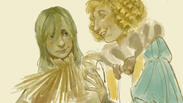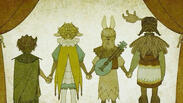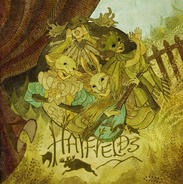4 Cradles


The Cradles came forth from the mother tree, a symbol of origin and nurturing. "It was then they rose with the sun, from below the humming groves came forth the mother trees: ‘The Four Cradles’." They swore to nurture its song, embodying their connection to the life force of the meadow and its stories.The Cradles represent four fundamental aspects of existence: past, future, truth, and entropy. This division echoes the classical elements of antiquity, such as the Greek elements of earth, air, fire, and water, each embodying essential qualities of life and the cosmos.Their emergence from the mother tree draws a parallel to the World Tree found in various mythologies, like Yggdrasil in Norse mythology, which connects different realms and sustains life. The Cradles' commitment to nurturing the song of the meadow highlights their role as guardians and preservers of balance and harmony in their world.
Others


The Majesty
The Majesty is the ruler of Meadowlark, and a complex figure whose decisions and obstinacy have significantly impacted the world. Described as foolish and stubborn, the Majesty's refusal to heed the warnings of the other Harkers, particularly regarding the Croon, sets the stage for a tragedy that resonates throughout the land. This tragedy is notably connected to the hills mentioned in Cole’s song of origin, symbolizing the far-reaching consequences of the Majesty’s hubris.The Majesty's refusal to listen to the Harkers' warnings about the Croon reflects a classical tragic flaw, or hamartia, akin to the hubris seen in Greek tragedies. Much like King Oedipus or King Lear, the Majesty's downfall is precipitated by a fatal lack of insight and an overestimation of their own wisdom. This theme of a ruler's folly leading to disaster is also echoed in literature, such as Shakespeare's portrayal of the tragic consequences of King Lear’s poor judgment.The Croon, a representation of change and entropy, was a crucial element that the Majesty chose to ignore. In mythology, disregarding the advice of seers and prophets often leads to catastrophe. The Harkers, as prophetic figures, parallel the Oracle of Delphi in Greek mythology, whose ignored prophecies often spelled doom for those who did not heed her warnings. The Croon’s association with inevitable change and chaos makes it a potent symbol of the natural forces that cannot be controlled, much like the Greek god Chaos, who embodies the void and the unpredictable nature of the cosmos.The Enkindled’s appearance to the Majesty in the form of a hound is rich with symbolic meaning. In many mythologies, dogs are seen as guides to the underworld and guardians of the dead, such as Cerberus in Greek mythology. This form can be interpreted as a warning of impending doom or a call to acknowledge the natural order. The hound’s presence signifies a protective yet ominous force, urging the Majesty to recognize the balance and harmony that the Enkindled embodies.
Korhys
Korhys, pronounced "Chorus," is a character whose past as a soldier and subsequent actions play a pivotal role in Cole's life and the broader narrative of Meadowlark. Once a soldier fighting against the roots, a force likely symbolic of encroaching natural elements, Korhys discovered a very young Cole in a hut that miraculously remained standing amidst the devastation of their village, which had been torn down or drowned by nature. The discovery of Cole was helped by the child's humming, which led Korhys to them.Korhys's decision to take Cole to safety, away from the hills, marked a significant departure from their duty. This act of compassion, abandoning their military role to protect and care for Cole, aligns Korhys with the archetype of the soldier who finds redemption or purpose in a nurturing role. This trope is prevalent in literature and mythology, where warriors often turn to acts of kindness and protection after experiencing the horrors of battle.The question of whether Korhys is dead or estranged is significant. All the children in the story are referred to as orphans, which raises the possibility that Korhys may have perished or is no longer present in Cole's life in a meaningful way. If Korhys were still alive, it begs the question of whether Cole would still be part of the found family that is the Lark.The notion of being an orphan can extend beyond biological ties to include anyone who has lost their parental figures, whether through death, abandonment, or estrangement.
The Baroness
The Baroness, also known as Enaïs, is introduced in Clémentine's song and plays a significant role in their backstory. As Clémentine's mother, she is depicted as a figure who embodies strictness yet retains an element of love.The Baroness's strict nature implies that she runs a household governed by rigid rules and high expectations. Such environments are often portrayed, where noble or aristocratic families impose stringent standards on their members. Despite her strictness, the Baroness is also described as loving, indicating that her actions, however harsh, may have been driven by a desire to protect or elevate Clémentine. This mirrors many characters, who, while often seen as purely villainous, can be interpreted as enforcing strict rules to ensure social survival and success.Given that all Larks are referred to as orphans, the Baroness might be deceased, or Clémentine's estrangement from her mother could be so profound that Clémentine considers herself orphaned in spirit. This idea of self-imposed orphanhood reflects a common literary theme where characters disown their families to forge their own identities, free from the constraints of their upbringing. This theme is explored in works like James Joyce's "A Portrait of the Artist as a Young Man," where Stephen Dedalus rejects his family's expectations to pursue his artistic vision.Clémentine’s desire to prove themselves and their eventual rebellion against their mother's strictures reflect a classic narrative of seeking independence and self-definition. The line "ran to be remembered" highlights Clémentine's drive to escape the suffocating environment and carve out a distinct identity. This journey is reminiscent of many coming-of-age stories, such as "Jane Eyre" by Charlotte Brontë, where the protagonist breaks free from oppressive guardians to find her own path.There is a large possibility that the Baroness is dead adding more tragedy to Clémentine's story. If true, it suggests that Clémentine's rebellion and escape may have occurred too late to reconcile with her mother, leaving a complex legacy of love and regret.

Songs


Hayfields
1. Hartebeest
2. Harpy Hare
3. And the Hound
4. Neath the grove is a heart
More to come..
⚠️ Not Finished ⚠️
Lore Explained!

Meadowlark is a quaint land where music and storytelling intertwine, centered around the Larks, four orphaned singers who wear masks and gain fame despite performing as a hobby. Each Lark corresponds to a mythical Harker, figures created by the Cradles to tell stories and maintain the world's rhythm. The Larks include Cole, Clémentine, Perrine, and Kingsley, each with unique ties to the Harkers. Themes of nature, memory, chaos, and fate are woven through their tales, creating an intriguing world to explore!Join us weary traveller, come to Meadowlark!
Yaelokre's Socials